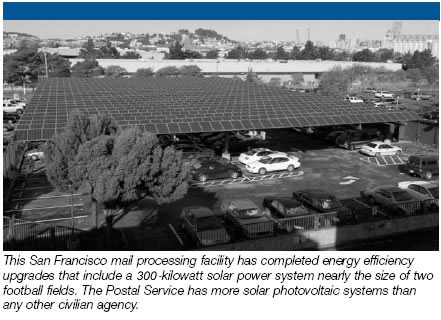Utilities
With more than 34,000 facilities, the Postal Service consumes a significant amount of energy, presenting a major opportunity to make a difference. The first step to reducing utility use is to go back to the basics — turning out lights, setting thermostats appropriately, closing doors, and turning equipment off when not in use. By educating employees on conservation best practices and holding everyone accountable for energy use, significant reductions will be achieved.
The Postal Service commits to a 20 percent reduction in facility energy use by 2012. It will reduce energy costs and consumption by focusing first on the largest facilities, which are estimated to consume about 60-70 percent of total facility energy expenses. These facilities will receive energy upgrades that meet or exceed federally mandated requirements. Improved energy oversight of facility resources will ensure the achievement of energy consumption targets.
Making utility expenses more visible is an essential component of conservation. The new Utility Management System (UMS) captures cost and usage data for electricity, natural gas, and fuel oil bill management. It will provide detailed utility consumption and cost profiles, bill payment, auditing, rate optimization, and reporting. Besides helping target conservation actions, UMS will guide the prioritization of energy infrastructure investments and reduce the cost of utility contracts. The system is currently being piloted in 600 facilities.
Comprehensive energy audits are being conducted in plants and other large facilities. An enterprise-wide energy management system is being developed that will allow for continuous monitoring of facility energy performance and quickly identify where utility-related repairs and modifications are needed. This system is key to ensuring that investments made to reduce energy consumption continue to achieve estimated savings.
The Postal Service will also reduce energy costs and minimize risk by using leveraged supply contracts in restructured electricity and natural gas markets. These contracts offer improved price stability and reduce risk by fixing supply costs during periods of volatility.
Sustainable Facility and Equipment Design

A variety of sustainable building design concepts have been integrated within the Postal Service‘s national standard design criteria. These criteria are used for all new construction as well as repair and alteration projects. The result is facilities that use less energy and have less impact on the environment. Examples of sustainable building concepts include use of high-efficiency lighting and HVAC, low-volatile organic compound paints, recycled-content materials, and low water use fixtures. The EPA has honored the Postal Service with its Environmental Achievement Award for its “green solutions” in the Pacific Area, including solar photovoltaic systems, fuel cells, and combined heat and power generation.
The Postal Service has incorporated energy efficient requirements into mail processing equipment designs. New standards such as power consumption, voltage, and temperature impact are now being reviewed as part of postal procurement procedures. The Flats Sequencing System is the first major purchase in which these new requirements were used. In addition, when procuring energy consuming products, ENERGYSTAR® and FEMP-designated products will be used where practicable.
In addition to the sustainable concepts incorporated into all of its projects, the Postal Service is continuing to evaluate new technologies and concepts to reduce its environmental impact. This includes living roofs where plant material is actually grown on the roof surface, which reduces the energy needs of the building, controls storm water, and reduces the heat island effect. These roofs are being evaluated for possible installation at a test facility this year.
Renewable energy systems also are continuing to be evaluated and different business models being developed in the market that will allow the Postal Service to effectively gain the value of energy produced through renewables at a cost that is competitive with power produced on the grid.
The Postal Service is conducting an inventory of its greenhouse gas emissions to serve as a baseline for improving its “carbon footprint.” The inventory includes all facilities, operations, and vehicles, and adheres to the California Climate Action Registry protocol, which has been adopted by 34 states. The Postal Service‘s early participation in the registry allows it to participate in ongoing policy and regulatory discussions.
Enhance Sustainability — Summary of Priorities
- Build a conservation culture throughout the Postal Service. Integrate energy conservation into day-to-day operations and engage every employee to take ownership and responsibility.
- Help customers go “green.” Encourage pickup and delivery to help consumers save time and reduce emissions and fuel use. Expand Cradle to Cradle certification to additional packaging.
- With the Greening of the Mail Task Force, guide efforts to improve address and list quality, expand mail recycling, and improve communication on the benefits of mail to the economy and society.
- Expand postal use of recycled and recyclable products. Help businesses and households recycle or dispose of materials using the mail.
- Reduce fuel use by the postal-owned fleet and transportation contractors. Continue to explore alternative fuel technologies, including flex-fuel, hybrid, and fuel cell.
- Reduce energy use in postal facilities by 20 percent in 5 years. Conduct energy upgrades on largest facilities and use sustainable building concepts for new construction and repair and alteration projects.

